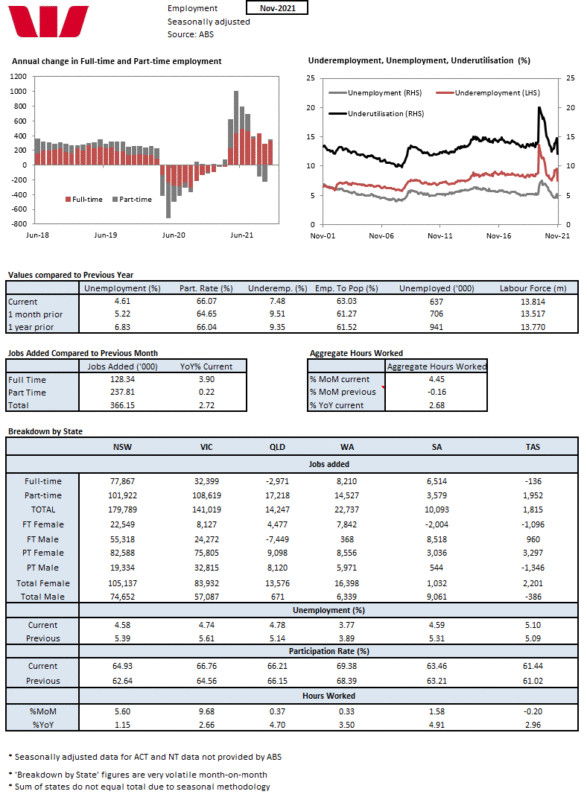A very solid update with a labour market significantly outperforming all expectations.
There is no doubt this is a very solid update highlighting a labour market significantly outperforming all expectations.
The November Labour Force Survey reported a spectacular 366.1k/2.9% gain in employment much stronger that Westpac’s and the market’s expectations (220k and 200k respectively) even pipping the top of the range forecast of 310k. It is also the largest single monthly gain on record going back to 1978.
Total employment is now higher than it was back in June 2021, pre the latest round of lockdowns.
Interestingly, most of the gains were in part-time employment, +237.8k, while full-time employment lifted a still very solid 128.3k.
Hours worked surged 4.5%, we had expected that hours worked would outperform the gains in employment but given the magnitude of the gains in employment this is a very solid update on economic activity.
Given the surge in hours worked it should be no surprise that underemployment also had a meaningful correction falling 2ppt to 7.5%, the lowest level of underemployment since January 2014.
As expected, there was as surge in workers returning to the labour force, +296.8k, which saw the participation rate lift to 66.1%, just shy of the June 2021 peak of 66.3%. However, this was not enough to counter the gains in employment and the unemployment rate fell to 4.6%, the lowest unemployment rate since December 2008, the peak of the mining boom.
Underutilisation, that is unemployment plus underemployment, fell from 14.7% to 12.1% the lowest level since August 2012. This is significant as we have found underutilisation to be a much better indicator of potential wages growth than unemployment on its own. This suggests meaningful upside risk to the outlook for wage inflation in 2022.
It is worth noting that for the last two months, the ABS estimate of the working age population contracted slightly again. The closure of the international borders is still biting and it will be interesting see where this goes in 2022 as the borders reopen.
The ABS noted that the easing of restrictions in NSW and Vic had a large influence on the national figures, with employment in the two states increasing by 180k and 141k. Employment in those states is only 52k and 4k (respectively) below May, having fallen by 250k and 145k during the lockdowns.
While the focus is on NSW and Vic it would be remiss not to note the strength of the labour market in the other states. Employment gained 14.2k in Qld, 22.7k in WA and 10.0k in SA. In terms of unemployment, it fell from 5.4% to 4.6% in NSW, 5.6% to 4.7% in Vic, 5.1% to 4.8% in Qld and from 5.3% to 4.6% in SA.














